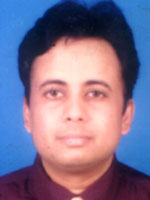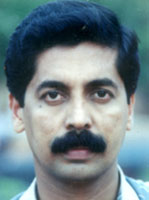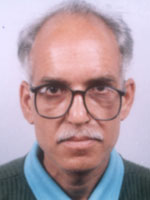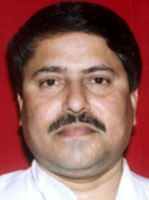|
Ratna
Bharali Talukdar
Organisation/publication: Sambhar (Sunday magazine of Asomiya Pratidin)
Place: Guwahati, Assam
Designation: Freelancer
Language: AssameseFocus:
The coalfields of Makum in Assam’s Tinsukia district
are her field of study. Consulting scientists and relevant experts she wants to find out
(i) if coal mining is done in a scientific manner (ii) whether post-mining treatment and
management of the mined areas has left any impact on the local flora and fauna, and (iii)
changes in the ecosystem due to mining over the years. She also wants to look at impact of
mining on water bodies, and the health impacts. She has mentioned the plight of the Tangsa
villagers, and wants to do a case study on impact of mining on livelihoods and village
economy.
Additionally, she will be looking at the issue of safety
of mine workers and the people living in the neighbouring areas and their health concerns.
What does the law say in this issue? Are its guidelines being followed in Makum? A health
index of the region of the last 30-40 years will be interesting.
Another set of interesting stories she will write is on
the issue of restoration of mines in the region. Are there any guidelines for restoration,
and are these being followed? How much money has been spent on restoration, and how much
have the mines generated for their owners?
^top
 Ejaz Kaiser Ejaz Kaiser
Organisation/publication: The Hindustan Times
Place: Raipur, Chhattisgarh
Designation: Staff Reporter
Language: English
Focus:
Ejaz will be focusing on diamond mining in the
Chhattisgarh. He will be doing stories on diamond mining in the state, in terms of the
future of this mining, policy implications, impact on people, ecology, water, etc.
The Chhattisgarh mining policy is opening the gates of the
state to all private companies and MNCs. Mapping licenses have been given to DeBeers and
other companies; investments have come from the Bharat Shah group as well. The subject of
diamond mining, thus, had immense possibilities.
^top
M T Shivakumar
Organisation/publication: Prajavani
Place: Bellary, Karnataka
Designation: District Correspondent
Language: Kannada
Focus:
- Shivakumar is looking at what mining has done to Bellary
– the existence of child labour in the mines, mining mafia and the involvement of
politicians, safety of mine workers, conditions of the migrant labour, revenue loss due to
illegal mines, degradation of environment, etc.
- Stories on some of the issues suggested by him will make
very interesting news. These are:
- Child labour in mines; and a study of enforcement of the
law in this context.
- Impact of mining on Hampi.
- The linkages between AIDS and mining; is the large migrant
labour population a factor?
- Changes in socio-cultural systems as a result of mining.
- The issue of trucks carrying mineral and overburden
through the area and the pollution caused by them.
^top
Braja Kishore Mishra
Organisation/publication: The Samaja
Place: Bhubaneshwar, Orissa
Designation: Freelancer
Language: Oriya
Focus:
- Braja Kishore will be focusing on POSCO, because it is of
contemporary interest. He will look at what will happen when POSCO comes, a critical
analyses of POSCO’s EIA.
- He will weave in the issues of environmental degradation,
livelihood issues and people’s protests, if any, around the story of POSCO.
People’s apprehensions about new projects, looking at the destruction mining has
caused in other districts of Orissa.
^top
 Sasidharan Mangathil Sasidharan Mangathil
Organisation/publication: Mathrubhumi
Place: Kottakkal, Kerala
Designation: Sub-editor
Language: Malayalam
Focus:
- Sasidharan’s region of study is Kollam and Alappuzha
districts in Kerala, and his subject is sand mining. He will be examining the technical
aspects related to the feasibility of sand mining in these areas.
^top
Shafi Rehman
Organisation/publication: The New Indian Express
Place: New Delhi
Designation: Staff Correspondent
Language: English
Focus:
- Shafi’s focus is the Alappuzha area, where he wants
to study the evolution of mass movements against sand mining and the role played in these
movements by local organisations and politicians.
- He will be extending his research and reportage to sand
mining in Tamil Nadu as well.
^top
 Mahesh Chandra Joshi Mahesh Chandra Joshi
Organisation/publication: Nainital Samachar
Place: Nainital, Uttaranchal
Designation: Assistant Editor
Language: Hindi
Focus:
Mahesh will be looking at mining in Almora, Pithoragarh,
Tehri, Nainital etc in Uttaranchal. His key areas of focus have been well-defined, and his
proposal concentrates on politics and mining in the region. Besides that, he will also
look at impact of mining on water resources and agriculture, and how mining has impacted
the socio-cultural set-up in the region.
^top
Anupama Kumari
Organisation/publication: Prabhat Khabar
Place: Ranchi, Jharkhand
Designation: News writer
Language: Hindi
Focus:
- Anupama’s proposal is to study the mining districts
in Jharkhand (Singhbhum, Hazaribagh, Dhanbad, Latehar etc), with the focus on the problems
of women and children. Besides her proposed areas of study, she will also look at and
report on public hearings and EIAs in the state.
^top
 Sunny Sebastian Sunny Sebastian
Organisation/publication: The Hindu
Place: Jaipur, Rajasthan
Designation: Special Correspondent
Language: English
Focus:
- Sunny will be studying marble mining industry in the
Rajnagar area in Rajsamand, south of Rajasthan, which despite being a comparatively
"young" mining area, is replete with problems, mostly manmade.
- He will be writing on the negative impacts of mining in
Rajnagar. Besides the government is not earning as much – it receives lower taxation
returns from local mines (Excise Duty having been withdrawn and Sales Tax taking a similar
cue – these issues need appraisal), the lone source is royalty on the mineral mined.
The mechanized mining and limited use. The age old methods – manual operations to dig
mines and pull out marble blocks, which fetch less price and consume more time besides
putting to waste plenty of marble all around in the process.
- More than this is the damage caused across the widespread
fields where local farmers, mostly tribals, would reap two harvests until some years ago.
Dumping marble-waste and (wet) slurry (coming out of the sawing process), the mine owners
have created mini-mounds all around. The wind sweeps the slurry to far off places,
spreading a white bed-sheet over the green fertile crop fields.
- The impact on the Rajsamand lake caused by the deep pits
that have been created over a vast chunk of area which was basically the water-shed for
the lake.
^top
Kulsum Talha
Organisation/publication: The Pioneer, Dainik Jagran
Place: Lucknow, UP
Designation: Freelancer
Language: English, Hindi
Focus:
- Kulsum is focusing on mining in Sonbhadra in UP. The
health problems and pollution generated due to the dust and sound by the crushers. The
influence of naxalism, which has deep roots in the region, on poor, illiterate and hungry
men due to no other job opportunities.
- She will also write on the corporate social responsibility
of the big financers and corporate houses. Are corporate houses following the rules and
regulations to carry out safe and scientific mining? While carrying out mining activities,
are they following the environment management plan and concurrent reclamation plan
including proper disposal of waste?
^top
Rumni Ghosh
Organisation/publication: Dainik Bhaskar
Place: Indore, Madhya Pradesh
Designation: City Correspondent
Language: Hindi
Focus:
- Rumni’s focus is on the impact of mining on the Panna
Tiger Reserve.
^top
 Raju Nayak Raju Nayak
Organisation/publication: Loksatta
Place: Goa
Designation: Principal Correspondent
Language: Marathi
Focus:
Raju’s proposal is on open cast iron mining in Goa.
He will be writing on issues related to impact of mining – agriculture, the Western
Ghats, water and rivers, rural culture and health. But his main focus will be on private
mining in Goa. The big names involved in this sector, but the mining practices are
outdated and reclamation is unheard of. Mining overburden is dumped in the ocean:
Goa’s much vaunted restoration and reclamation is nothing but a farce.
Also, Raju will focus on the impact of mining on drinking
water, water bodies and groundwater. He could follow up on the work of the Supreme
Court’s committee looking into impact of mining and why its report was not made
public.
^top
|